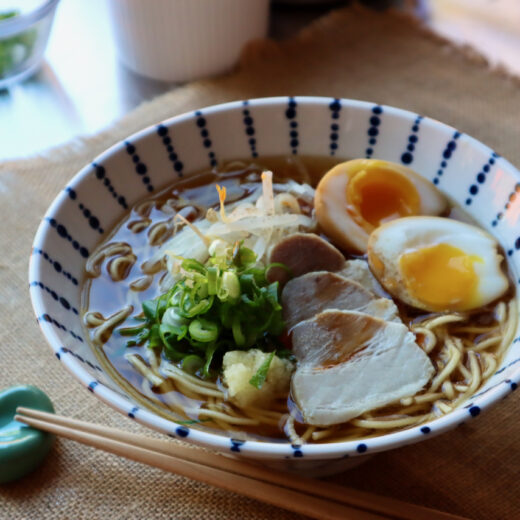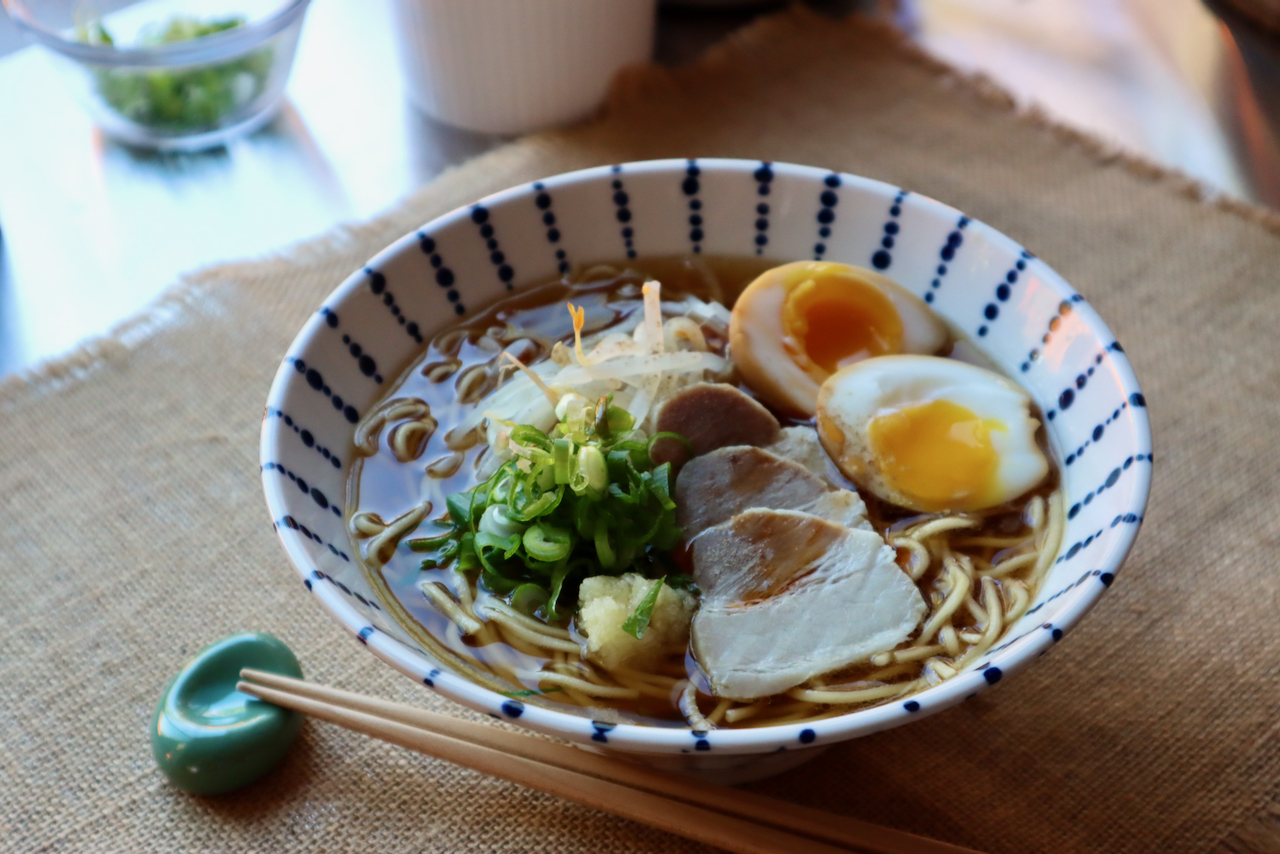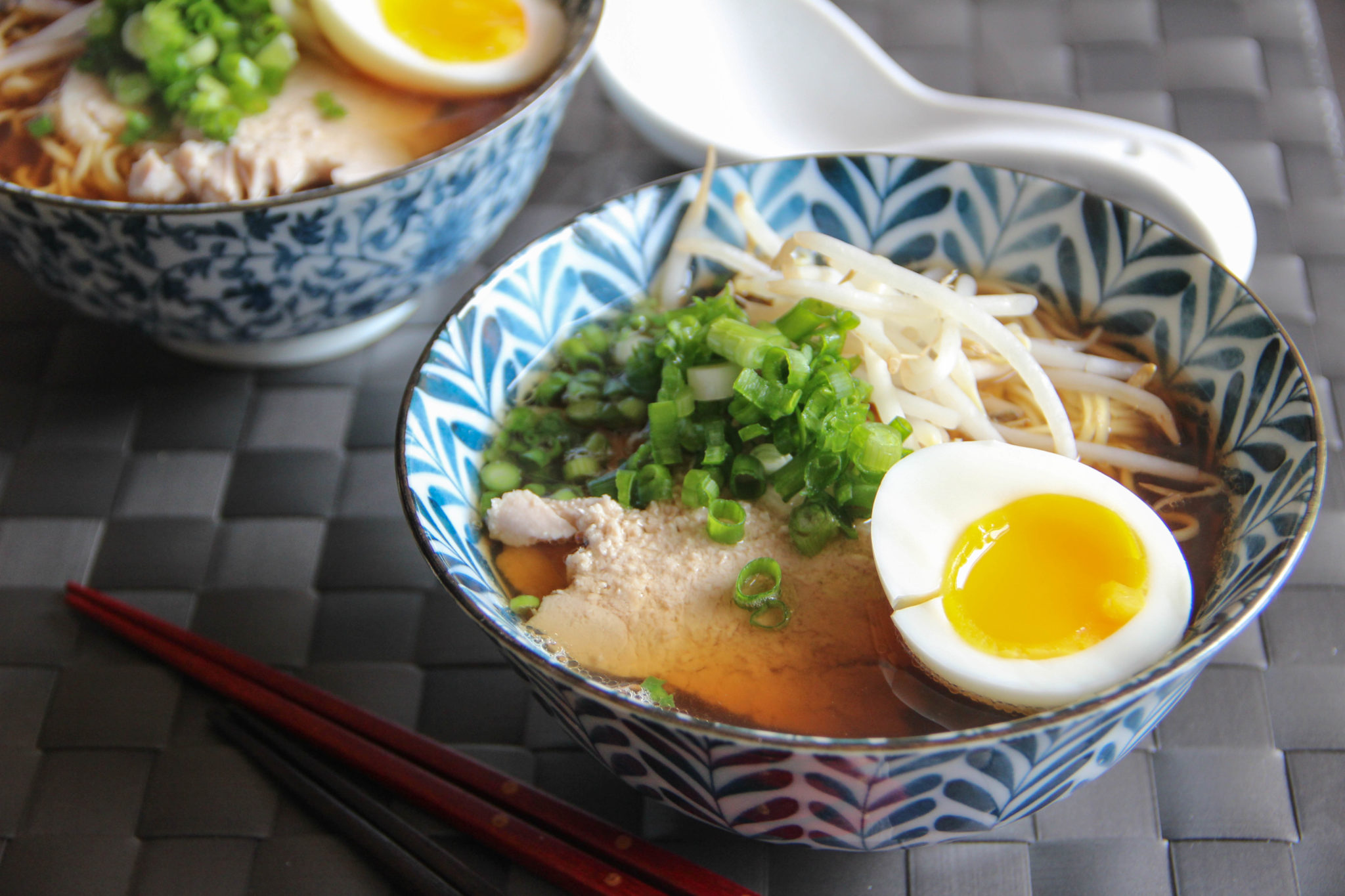Ramen is Chinese-style noodles served in strongly seasoned hot soup with various toppings. Ramen has been a very popular dish in Japan for many years. Now the world is catching up with us. Ramen shops are absolutely everywhere, inside and outside Japan. And people just love it.
Ramen noodles originally came from a Chinese noodle soup dish, but it’s been changed to more Japanese taste and then improved over many years. Today it has evolved into a huge part of Japanese cuisine and culture. There are millions of Ramen restaurants in Japan from mom and pop Chinese restaurants in neighborhoods, Ramen street carts open late at night, to more sophisticated Ramen specialty shops in cities. People don’t mind lining up for hours and consider the wait worthwhile as long as they can get delicious Ramen. A lot of restaurants make their own fresh noodles at their restaurants daily, and cook the soup from meat, fish, and various aromatic vegetables taking hours or even days sometimes. Those fresh noodles at restaurants are of course the best, but another form of Ramen that is very popular in Japan is instant noodles. It’s become a whole Japanese food sub-culture. There are millions of kinds of instant Ramen you can buy at supermarkets over there, and some are so good that they could taste better than so-so Ramen shops.
There are two main components in Ramen: noodles and soup. The noodles are called Chinese-style noodles (Chuka-men-中華麺), but Japanese Chuka noodles are really nothing like noodles in Chinese noodle soup dishes anymore. Japanese Ramen noodles are usually wheat noodles with a firm and chewy texture. The firm texture is very important for Ramen noodles because they could get soft while sitting in the hot soup. Nobody wants to eat soft expanded noodles that have absorbed too much soup! Unfortunately, it is pretty hard to find good Ramen noodles you can buy for home cooking Ramen outside Japan. If you’re lucky enough to find good dried Chuka-men from Japan, or even better, fresh Chuka-men, use that. Surprisingly, dried thin spaghetti is a pretty good alternative for Chuka-men because of its firmness. If you prefer softer texture, angel hair pasta will work too. The key is to boil those pastas in water with baking soda because that creates a distinct Ramen noodle flavor. It may be a good idea to cook pastas a minute less than the package directions because they will continue to cook in the hot soup while you’re eating.
The other important component of Ramen is the soup. Generally speaking, there are three basic types of Ramen soups in Japan: Shoyu (soy sauce), Miso, and Shio (salt). Usually bone-in pork and chicken or seafood broth is used for the base of the soup, and that is then seasoned with soy sauce, miso, or salt. The big traditional three soup flavors also branch out into many many different kind of soups thanks to each Ramen chef’s philosophy and regional specialty. If you include new fusion Ramen, there are uncountable numbers of Ramen soup flavors out there.
Sadly we are not Ramen artisans, so we made a very basic soy sauce flavor soup in this recipe. Our soup is simple and easy to make with very accessible ingredients, but it has plenty of good flavor. Anybody can make it! Pork belly is very fatty but it gives soup a wonderful taste, and cooked pork itself works as a topping. Just cool the soup and remove any excess fat from the soup. As mentioned above, there could be many combinations of flavors for soups. So if you want to experiment with different ingredients, go for it. Hope you can find the taste of Ramen you enjoy!
This video and article is newly updated from 2013.

Ramen Recipe
Ingredients
Salted pork
- 1 lb pork belly
- 2 tsp salt
Soup
Noodles
- 3-4 bunches dried Chukamen noodles
or if using pasta
- 10 oz dried thin spaghetti
- 8 cups water
- 2 Tbsp baking soda
Topping
- soft boiled egg halved
- bean sprouts blanched briefly
- green onions cut finely
Instructions
- Rub salt on pork and let it sit overnight in the fridge.
- Put water, ginger root, garlic, green onions and salted pork in a pot, and boil at high heat. Skim fat and other floating scum. Then cover, reduce to low heat, and simmer for 1 1/2 to 2 hours. (Or cook in a pressure cooker for 20 minutes. ) Let the broth and pork cool completely in pot. Strain and save the separated broth and pork.
- Let the broth cool in the fridge at least a couple of hours or overnight, and then remove the solidified fat. Keep cooked pork in the fridge too so that it can be easily sliced later.
- Prepare the rest of the toppings now as well (boiled eggs, blanched bean sprouts, cut green onions), before making the soup and noodles. Once the noodles are cooked, you will need to add the soup and toppings right away or the noodles will get soft, so you won't have time to prepare the toppings then.
- Boil the broth and add soy sauce, sake, salt and sesame oil. Let it simmer at very low heat until the noodles are ready.
- Cook dried Chuka dried noodles according to the package. Just before the noodles are done, pour the soup in serving bowls. Strain water from the noodles and immediately divide the noodles into the serving bowls.
- If you are using dried thin spaghetti: In boiling water in a pot, add baking soda (be careful, it may boil over), then the spaghetti. Cook the pasta according to the package, and strain. Immediately divide noodles into bowls with the soup.
- Top with boiled eggs, bean sprouts, green onions and sliced pork.
Video
Notes


